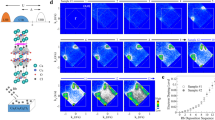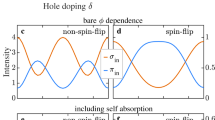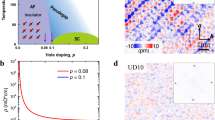Abstract
The introduction of holes in a parent compound consisting of copper oxide layers results in high-temperature superconductivity. It is also possible to dope the cuprate parent compound with electrons1,2,3. The physical properties of these electron-doped materials bear some similarities to but also significant differences from those of their hole-doped counterparts. Here, we use a recently developed first-principles method4 to study the electron-doped cuprates and elucidate the deep physical reasons behind their behaviour being so different from that of the hole-doped materials. The crystal structure of the electron-doped compounds is characterized by a lack of apical oxygens, and we find that it results in a parent compound that is a Slater insulator—a material in which the insulating behaviour is the result of the presence of magnetic long-range order. This is in sharp contrast with the hole-doped materials, which are insulating owing to the strong electronic correlations but not owing to magnetism.
This is a preview of subscription content, access via your institution
Access options
Subscribe to this journal
Receive 12 print issues and online access
$259.00 per year
only $21.58 per issue
Buy this article
- Purchase on SpringerLink
- Instant access to full article PDF
Prices may be subject to local taxes which are calculated during checkout



Similar content being viewed by others
References
Armitage, N. P. et al. Angle-resolved photoemission spectral function analysis of the electron-doped cuprate Nd1.85Ce0.15CuO4 . Phys. Rev. B. 68, 064517 (2003).
Takagi, H. et al. Superconductivity produced by electron doping in CuO2-layered compounds. Phys. Rev. Lett. 62, 1197–1200 (1989).
Tokura, Y. et al. Electron and hole doping in Nd-based cuprates with single-layer CuO2 sheets: Role of doped Ce ions and 30-K superconductivity. Phys. Rev. B 39, 9704–9707 (1989).
Kotliar, G. et al. Electronic structure calculations with dynamical mean-field theory. Rev. Mod. Phys. 78, 865–951 (2006).
Zaanen, J. et al. Band gaps and electronic structure of transition-metal compounds. Phys. Rev. Lett. 55, 418–421 (1985).
Slater, J. C. Quantum Theory of Molecules and Solids Vol. 4. (McGraw-Hill, 1974).
Kotliar, G. Strong correlation transport and coherence. Int. J. Mod. Phys. B 5, 341–352 (1991).
Schmalian, J. et al. Doping dependence of local magnetic moments and antiferromagnetism in high-Tc superconductors: Asymmetry between electron and hole doping. Solid State Commun. 86, 119–122 (1993).
Baumgartel, G. et al. Theory for the electronic structure of high-Tc superconductors. Phys. Rev. B 48, 3983–3992 (1993).
Comanac, A. et al. Optical conductivity and the correlation strength of high temperature copper-oxide superconductors. Nature Phys. 4, 287–290 (2008).
Georges, A. et al. Dynamical mean-field theory of strongly correlated fermion systems and the limit of infinite dimensions. Rev. Mod. Phys. 68, 13–125 (1996).
Weber, C. et al. Optical weights and waterfalls in doped charge-transfer insulators: A local density approximation and dynamical mean-field theory study of La2−xSrxCuO4 . Phys. Rev. B. 78, 134519 (2008).
Matsui, H. et al. ARPES study of quasiparticle state in electron-doped cuprate Nd2CexCuO4 . J. Phys. Chem. Solids 67, 249–253 (2006).
Xiang, T. et al. Intrinsic electron and hole bands in electron-doped cuprate superconductors. Phys. Rev. B 79, 014524 (2009).
Xiang, T. et al. Intrinsic electron and hole bands in electron-doped cuprate superconductors. Phys. Rev. B 79, 014524 (2009).
Zimmers, A. et al. Infrared properties of electron-doped cuprates: Tracking normal-state gaps and quantum critical behavior in Pr2−xCexCuO4 . Europhys. Lett. 70, 225–231 (2005).
Onose, Y. et al. Doping dependence of pseudogap and related charge dynamics in Nd2−xCexCuO4 . Phys. Rev. Lett. 87, 217001 (2001).
Onose, Y. et al. Charge dynamics in underdoped Nd2−xCexCuO4: Pseudogap and related phenomena. Phys. Rev. B 69, 024504 (2004).
Uchida, S. et al. Optical spectra of La2−xSrxCuO4: Effect of carrier doping on the electronic structure of the CuO2 plane. Phys. Rev. B 43, 7942–7954 (1991).
Bontemps, N. et al. Temperature dependence of the spectral weight in p- and n-type cuprates: A study of normal state partial gaps and electronic kinetic energy. Ann. Phys. 321, 1547–1558 (2006).
Mermin, N. D. et al. Absence of ferromagnetism or antiferromagnetism in one- or two-dimensional isotropic heisenberg models. Phys. Rev. Lett. 17, 1133–1136 (1966).
Mang, P. K. et al. Spin correlations and magnetic order in non-superconducting Nd2−xCexCuO4±δ . Phys. Rev. Lett. 93, 027002 (2004).
Borsa, F. et al. Staggered magnetization in La2−xSrxCuO4 from 139La NQR and μSR : Effects of Sr doping in the range 0<x<0.02. Phys. Rev. B. 52, 7334–7345 (1995).
Kyung, B. et al. Pseudogap and spin fluctuations in the normal state of the electron-doped cuprates. Phys. Rev. Lett. 93, 147004 (2004).
Stadlober, B. et al. Is Nd2−xCexCuO4 a high-temperature superconductor? Phys. Rev. Lett. 74, 4911–4919 (1995).
Ismer, J-P. et al. Multiband superconductivity in spin density wave metals. Preprint at http://arxiv.org/abs/0907.1296 (2009).
Acknowledgements
We thank A. M. Tremblay, D. Basov, D. G. Hawthorn and G. A. Sawatzky for discussions and sharing their insights and experimental data. Discussions with A. Georges, A. Amaricci, J. C. Domenge and A. Millis are acknowledged. J-C. Dommenge shared his exact diagonalization code. K.H was supported by Grant NSF NFS DMR-0746395 and the Alfred P. Sloan foundation. G.K. was supported by NSF DMR-0906943, and C.W. was supported by the Swiss National Science Foundation (SNSF).
Author information
Authors and Affiliations
Contributions
C.W., K.H. and G.K. conceived the research; C.W. carried out numerical calculations; C.W. and K.H. contributed theoretical numerical codes; C.W. analysed the data; C.W., K.H. and G.K. wrote the paper; G.K. supervised the whole project.
Corresponding author
Ethics declarations
Competing interests
The authors declare no competing financial interests.
Supplementary information
Supplementary Information
Supplementary Information (PDF 212 kb)
Rights and permissions
About this article
Cite this article
Weber, C., Haule, K. & Kotliar, G. Strength of correlations in electron- and hole-doped cuprates. Nature Phys 6, 574–578 (2010). https://doi.org/10.1038/nphys1706
Received:
Accepted:
Published:
Issue date:
DOI: https://doi.org/10.1038/nphys1706
This article is cited by
-
Annealing and doping effects on magnetism for T\(^{*}\)-type (La, Eu, Sr)\(_2\)CuO\(_{4-y}\)F\(_y\) cuprates
Interactions (2024)
-
Doping-dependent superconducting physical quantities of K-doped BaFe\(_2\)As\(_2\) obtained through infrared spectroscopy
Scientific Reports (2022)
-
Dynamic and Static Exponents in FFH Scaling Using Superfluid Phase Stiffness in Co-doped Superconducting Systems
Journal of Superconductivity and Novel Magnetism (2022)
-
Momentum-resolved visualization of electronic evolution in doping a Mott insulator
Nature Communications (2021)
-
Orbital structure of the effective pairing interaction in the high-temperature superconducting cuprates
npj Quantum Materials (2021)



